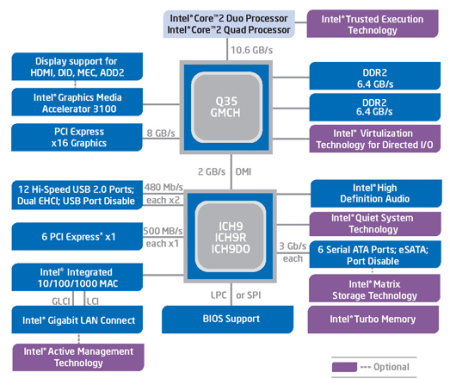PICMG card debuts Intel’s Q35 chipset
Dec 6, 2007 — by Eric Brown — from the LinuxDevices Archive — 18 views Industrial computer manufacturer IEI Technology Corp. announced a new PICMG 1.3 CPU card based on Intel's Q35 Express Chipset. The PCIE-Q350 is one of the first cards based on the power-efficient Q35, which supports upcoming 45nm versions of Intel Core 2 Duo processors.
Industrial computer manufacturer IEI Technology Corp. announced a new PICMG 1.3 CPU card based on Intel's Q35 Express Chipset. The PCIE-Q350 is one of the first cards based on the power-efficient Q35, which supports upcoming 45nm versions of Intel Core 2 Duo processors.
(Click for larger view of the PCIE-Q350)
The heir apparent to the Intel Q965 chipset, the Q35 and its close cousin, the Q33, are equipped with a PCI Express 1.1 interface, Intel Graphic Media Accelerator 3100 and Intel Rapid Recover technology. The difference between the chipsets, says Intel, is that the Q35 adds hardened security, strong data protection, ease of manageability, and lower power consumption.

Intel Q35 Chipset block diagram
(Click to enlarge)
Both chipsets offer 1333/1066/800MHz system buses, a fast memory access updated graphics memory controller hub (GMCH) backbone architecture, and dual-channel DDR2 memory support, says Intel. The chipsets are also said to support high-definition audio, matrix storage technology, and external SATA.
The IEI PCIE-Q350 takes advantage of the Q35's Intel Active Management Technology (AMT) 3.0 and its hardware-based isolation and recovery to provide remote system boot, control, asset management, and smart network security management, says IEI. The company also adds third-party management and security applications, which IEI says combines with AMT to help reduce IT management costs. The company is targeting the card at applications that require high data transmission rates, including surveillance systems, automation control systems, and high-end measurement and data acquisition equipment.
The PCIE-Q350 feature set includes:
- Processor — Intel Q35 + ICH9-DO (supports LGA775 45nm Intel Core 2 Quad (Yorkfield), Core 2 Duo (Wolfdale) , Core 2 Duo, Celeron at FSB 800/1066/1333MHz
- BIOS — AMI BIOS Label with 8MB SPI EEPROM
- Memory — 4 x 240pin DIMM socket dual channel DDRII at 800/667MHz (up to 8GB)
- Ethernet — Dual GbE LAN1: Intel 82566DM (PHY); LAN2: Intel 82573L(MAC + PHY)
- USB — 12 x USB 2.0 (2 on bracket, 6 on board by pin header, 4 on backplane by pin header)
- Other I/O — 2 x RS-232; 6 x SATA II, supports RAID 0, 1, 10, 5; 1 x 6-pin header on board for KB&MS
- Digital I/O — 8-bit (4-bit input / 4-bit output)
- IrDA — 1 x IrDA by pin header
- Audio — 10-pin header on board supports 7.1 channel HD Audio by IEI AC-KIT-883HD
- Graphics — Analog VGA output; SDVO port
- TPM1.2 — 1 x 20-pin header on board for TPM (Trusted Platfom Module)
- Watchdog Timer — Software programmable, supports 1~255sec. system reset
- Power Supply — ATX-based, 3.3V-3.0A, 5V-5.1A, 5Vsb-0.28A, 12V-4.23A(2DMark 2001); Intel Core 2 Duo E6700 2.66GHz at FSB1066, 8GB DDR2 667MHz, 3DMark 2001
- Temperature range — 0ºC ~ 60ºC (32ºF ~ 140ºF)
- Humidity range — 5% ~95% non-condensing
- Dimensions — 13.3 x 5 inches (338mm x 126mm)
- Weight — 2.42 pounds (1.1kg)
About PICMG 1.3
PICMG 1.3 is a System Host Board (SHB) specification from the PCI Industrial Manufacturers Group that adapts PCI to passive backplane implementations required in demanding environments such as industrial automation, military, medical, and telecom. The original PICMG 1.0 defined pin-outs for the ISA (original PC/AT bus) and parallel PCI buses to the backplane. PICMG 1.2 added support for PCI-X. PICMG 1.3 addresses the bandwidth issues created by contemporary processors, by substituting PCI Express for the parallel buses.
Availability
Pricing and availability information on the PCIE-Q350 was unavailable, but more information is available here. IEI has also announced an IMB-Q354 microATX-based industrial motherboard based on the Q35, but there was no information available on the product. IEI makes no claims of Linux support at this stage. However, patches adding Q33/Q35 chipset and graphics support were merged into the mainstream 2.6-series Linux kernel this summer.
This article was originally published on LinuxDevices.com and has been donated to the open source community by QuinStreet Inc. Please visit LinuxToday.com for up-to-date news and articles about Linux and open source.